Conformity of the NASADEM_HGT and ALOS AW3D30 DEM with the Altitude from the Brazilian Geodetic Reference Stations: A Case Study from Brazilian Cerrado
Abstract
:1. Introduction
2. Background
2.1. Brazilian Geodetic System (SGB)
- Planialtimetric network: set of satellite-based geodetic stations, classified as GPS or Doppler, and the polygonal stations and triangulation vertices based on conventional surveying [20].
- Altimetric network: set of reference levels for vertical positioning and composed of high precision geometric leveling measurements [21]. In 2018, this network was adjusted by geopotential numbers, where gravity observations in reference levels were considered with the objective of obtaining physically meaningful altitudes, resulting in normal–orthometric altitudes [22]. In this study, it was not possible to use the SGB’s altimetry network as a reference, determined through the reference levels, since IBGE has not launched the quasi-geoidal model yet to which the normal orthometric altitudes of the reference levels will be referred. This quasi-geoidal model is necessary for the conversion of the orthometric altitudes of the DEMs to the reference system of the IBGE´s planialtimetric stations used in the study.
- Gravimetric network: a set of geodetic stations, called gravimetric stations, which contain information of the gravity acceleration and stations’ characteristics [23].
2.2. Brazilian Standard of Positional Accuracy
- Ninety percent of the samples points in a cartographic product shall present values of positional discrepancies equal to or less than the PEC tolerance value (1.6449*EP) of the scale and class tested, when compared with corresponding ground truth data.
- The RMSE of the positional discrepancies must be equal to or less than the EP tolerance defined for each scale and class.
3. Materials and Methods
3.1. Study Area
3.2. Planialtimetric Reference Data
3.3. Digital Elevation Models
3.3.1. NASADEM_HGT
3.3.2. AW3D30
3.4. Validation
- Computation of the geoidal undulation of the EGM96 model from a 15′ grid file provided by the National Geospatial Intelligence Agency (NGA). A 30-meter spatial resolution grid was generated using the Spline interpolation method available in the GRASS software [50].
- Calculation of the ellipsoidal height (h), obtained by the sum of the geoid undulation (N) and the orthometric height H (h = H + N) [51]. H (datum: EGM96) was converted into h (datum: WGS84) based on the addition of the EGM96 geoid undulation values obtained in the previous step.
- Computation of the geoidal undulation for the determination of orthometric altitude (Imbituba vertical datum) using input grid of the MAPGEO2015 software (5′ interval). This file was also interpolated to 30 m using the Spline interpolation method in the GRASS software.
- Conversion of the ellipsoidal altitude (WGS84) into the orthometric altitude referenced to the Imbituba vertical datum based on the subtraction of the geoidal undulation values obtained in the previous step.
- Conversion of the WGS84 horizontal datum to SIRGAS 2000 horizontal datum.
- The same script was also used to obtain the altitudes of the resulting raster GRID over the reference stations. These values were described in terms of mean, standard deviation, quartiles, and coefficient of variation, as well as with the support of boxplots, scatterplots, and histograms. We detected the presence of four outliers in the DEM models and in the reference altitudes (Figure 2), indicating equivalence among these outliers and corroborating the impression of high conformity among these datasets, i.e., the distribution of these three datasets is practically the same.
3.5. Comparison of DEMs in Eight Municipalities with the Highest Grain Production in the Cerrado
4. Results
4.1. Descriptive Analysis of DEMs Against the Reference Stations
4.2. Classification of DEMs Considering PEC-PCD
4.3. Descriptive Analysis of DEMs in the Municipalities with the Highest Grain Production in the Cerrado
4.4. Comparison of DEMs in Agricultural Areas of Municipalities with the Highest Grain Production in the Cerrado Using the Size of Cohen Effect (dc)
5. Discussion
6. Conclusions
Author Contributions
Funding
Institutional Review Board Statement
Informed Consent Statement
Data Availability Statement
Acknowledgments
Conflicts of Interest
References
- Nikolakopoulos, K.G. Accuracy assessment of ALOS AW3D30 DSM and comparison to ALOS PRISM DSM created with classical photogrammetric techniques. Eur. J. Remote Sens. 2020, 53, 39–52. [Google Scholar] [CrossRef]
- Grohmann, C.H. Evaluation of TanDEM-X DEMs on selected Brazilian sites: Comparison with SRTM, ASTER GDEM and ALOS AW3D30. Remote Sens. Environ. 2018, 212, 121–133. [Google Scholar] [CrossRef] [Green Version]
- Farr, T.G.; Rosen, P.A.; Caro, E.; Crippen, R.; Duren, R.; Hensley, S.; Kobrick, M.; Paller, M.; Rodriguez, E.; Roth, L.; et al. The Shuttle Radar Topography Mission. Rev. Geophys. 2007, 45, 33. [Google Scholar] [CrossRef] [Green Version]
- Abrams, M.; Crippen, R.; Fujisada, H. ASTER global digital elevation model (GDEM) and ASTER global water body dataset (ASTWBD). Remote Sens. 2020, 12, 1156. [Google Scholar] [CrossRef] [Green Version]
- Florinsky, I.V.; Skrypitsyna, T.N.; Luschikova, O.S. Comparative accuracy of the AW3D30 DSM, ASTER GDEM, and SRTM1 DEM: A case study on the Zaoksky testing ground, Central European Russia. Remote Sens. Lett. 2018, 9, 706–714. [Google Scholar] [CrossRef]
- Rizzoli, P.; Martone, M.; Gonzales, C.; Wecklich, C.; Tridon, D.B.; Brautigam, B.; Backmann, M.; Schulze, D.; Fritz, T.; Huber, M.; et al. Generation and performance assessment of the global TanDEM-X digital elevation model. ISPRS J. Photogramm. Remote Sens. 2017, 132, 119–139. [Google Scholar] [CrossRef] [Green Version]
- Crippen, R.; Buckley, S.; Agram, P.; Belz, E.; Gurrola, E.; Hensley, S.; Kobrick, M.; Lavalle, M.; Martin, J.; Neumann, M.; et al. NASADEM global elevation model: Methods and progress. Int. Arch. Photogramm. Remote Sens. Spat. Inf. Sci. 2016, XLI-B4, 125–128. [Google Scholar] [CrossRef]
- Tadono, T.; Nagai, H.; Ishida, H.; Oda, F.; Naito, S.; Minakawa, K.; Iwamoto, H. Generation of the 30-m-mesh global digital surface model by ALOS PRISM. Int. Arch. Photogramm. Remote Sens. Spat. Inf. Sci. 2016, XLI-B4, 157–162. [Google Scholar] [CrossRef]
- Buckley, S. NASADEM_HGT v001 (NASADEM Merged DEM Global 1 Arc Second), EarthData, NASA. 2019. Available online: https://lpdaac.usgs.gov/products/nasadem_hgtv001/ (accessed on 10 December 2020).
- Yap, L.; Kandé, L.H.; Nouayou, R.; Kamguia, J.; Ngouh, N.A.; Makuate, M.B. Vertical accuracy evaluation of freely available latest high-resolution (30 m) global digital elevation models over Cameroon (Central Africa) with GPS/leveling ground control points. Int. J. Digit. Earth 2018, 12, 500–524. [Google Scholar] [CrossRef]
- Uuemaa, E.; Ahi, S.; Montibeller, B.; Muru, M.; Kmoch, A. Vertical accuracy of freely available global digital elevation models (ASTER, AW3D30, MERIT, TanDEM-X, SRTM, and NASADEM). Remote Sens. 2020, 12, 3482. [Google Scholar] [CrossRef]
- Vaka, D.S.; Kumar, V.; Rao, Y.S.; Deo, R. Comparison of various DEMs for height accuracy assessment over different terrains of India. In Proceedings of the IEEE International Geoscience and Remote Sensing Symposium (IGARSS 2019), Yokohama, Japan, 28 July–2 August 2019; pp. 1998–2001. [Google Scholar] [CrossRef]
- Gdulová, K.; Marešová, J.; Moudrý, V. Accuracy assessment of the global TanDEM-X digital elevation model in a mountain environment. Remote Sens. Environ. 2020, 241, 111724. [Google Scholar] [CrossRef]
- Gonzáles-Moradas, M.R.; Viveen, W. Evaluation of ASTER GDEM2, SRTMv.3.0, ALOS AW3D30 and TanDEM-X DEMs for the Peruvian Andes against highly accurate GNSS ground control points and geomorphological-hydrological metrics. Remote Sens. Environ. 2020, 237, 111509. [Google Scholar] [CrossRef]
- Viel, J.A.; Rosa, K.K.; Mendes Júnior, C.W. Avaliação da acurácia vertical dos modelos digitais de elevação SRTM, ALOS World 3D e ASTER GDEM: Um estudo de caso no Vale dos Vinhedos, RS–Brasil. Rev. Bras. Geogr. Fís. 2020, 13, 2255–2268. [Google Scholar] [CrossRef]
- Barbosa, V.R.F.; Cicerelli, R.E.; Almeida, T.; Marotta, G.S.; Rodrigues, S.W.P. ALOS PRISM (AW3D05 Standard) and Sentinel-1: Evaluation of new sources of digital elevation models. Rev. Bras. Geogr. Fís. 2020, 13, 2319–2331. [Google Scholar]
- IBGE. Especificações e Normas Gerais para Levantamentos Geodésicos em Território Brasileiro; IBGE: Rio de Janeiro, Brazil, 1983. [Google Scholar]
- IBGE. Banco de Dados Geodésicos-BDG-o Que é. Available online: https://www.ibge.gov.br/geociencias/informacoes-sobre-posicionamento-geodesico/rede-geodesica/16327-banco-de-dados-geodesicos.html?=t=o-que-e (accessed on 8 August 2020).
- Brazil. Decreto Nº 243, de 28 de Fevereiro de 1967, Fixa as Diretrizes e Bases da Cartografia Brasileira. 1967. Available online: http://www.planalto.gov.br/ccivil_03/Decreto-Lei/1965-1988/Del0243.htm (accessed on 7 August 2020).
- IBGE. Sobre a Publicação-Rede Planialtimétrica. Available online: https://www.ibge.gov.br/geociencias/informacoes-sobre-posicionamento-geodesico/rede-geodesica/16284-rede-planialtimetrica.html?=t=sobre (accessed on 7 October 2020).
- IBGE. Rede Altimétrica-o Que é. Available online: https://www.ibge.gov.br/geociencias/informacoes-sobre-posicionamento-geodesico/rede-geodesica/16283-rede-altimetrica.html?=t=o-que-e (accessed on 8 August 2020).
- IBGE. Relatório: Reajustamento da Rede Altimétrica com Números Geopotenciais-REALT-2018; IBGE: Rio de Janeiro, Brazil, 2018; 47p. [Google Scholar]
- IBGE. Rede Gravimétrica-o Que é. Available online: https://www.ibge.gov.br/geociencias/informacoes-sobre-posicionamento-geodesico/rede-geodesica/16286-rede-gravimetrica.html?=&t=o-que-e (accessed on 8 August 2020).
- Brazil. Decreto N° 89.817 de 20 de Junho de 1984. Normas Técnicas da Cartografia Nacional. 1984. Available online: http://www.planalto.gov.br/ccivil_03/decreto/1980-1989/D89817.htm (accessed on 20 September 2020).
- DSG. Especificações Técnicas para a Aquisição de Dados Geoespaciais Vetoriais (ET-ADGV), 2nd ed.; DSG: Brasília, Brazil, 2016. [Google Scholar]
- DSG. Especificação Técnica de Controle de Qualidade de Dados Geoespaciais (ET-CQDG); DSG: Brasília, Brazil, 2016. [Google Scholar]
- Santos, A.P.; Rodrigues, D.D.; Santos, N.T.; Gripp, J., Jr. Avaliação da acurácia posicional em dados espaciais utilizando técnicas de estatística espacial: Proposta de método e exemplo utilizando a norma brasileira. Bol. Ciênc. Geod. 2016, 22, 630–650. [Google Scholar] [CrossRef] [Green Version]
- Carvalho, J.A.B.; Silva, D.C. Métodos para avaliação da acurácia posicional altimétrica no Brasil. Rev. Bras. Cart. 2018, 70, 725–744. [Google Scholar] [CrossRef]
- IBGE. Biomas e Sistema Costeiro-Marinho do Brasil: Compatível com a Escala 1:250.000, Relatórios Metodológicos; IBGE: Rio de Janeiro, Brazil, 2019; Volume 45, 168p. [Google Scholar]
- Myers, N.; Mittermeier, R.A.; Mittermeier, C.G.; Fonseca, G.A.B.; Jennifer, K. Biodiversity hotspots for conservation priorities. Nature 2000, 403, 853–858. [Google Scholar] [CrossRef]
- Bolfe, E.L.; Sano, E.E.; Campos, S.K. (Eds.) Dinâmica Agrícola do Cerrado-Análises e Projeções; Brasília: Embrapa, Brazil, 2020; 308p. [Google Scholar]
- Santana, C.A.M.; Campos, S.K.; Marra, R.; Aragão, A.A. Cerrado: Pilar da agricultura brasileira. In Dinâmica Agrícola do Cerrado-Análises e Projeções; Bolfe, E.L., Sano, E.E., Campos, S.K., Eds.; Brasília: Embrapa, Brazil, 2020; pp. 39–58. [Google Scholar]
- Sano, E.E.; Rosa, R.; Scaramuzza, C.A.M.; Adami, M.; Bolfe, E.L. Land use dynamics in the Brazilian Cerrado in the period from 2002 to 2013. Pesq. Agropec. Bras. 2019, 54, e00138. [Google Scholar] [CrossRef]
- Farr, T.G.; Kobrick, M. Shuttle Radar Topography Mission produces a wealth of data. Eos Trans. Am. Geophys. Union 2000, 81, 583–585. [Google Scholar]
- Orlandi, A.G.; Carvalho Júnior, O.A.; Guimarães, R.F.; Bias, E.S.; Corrêa, D.C.; Gomes, R.A.T. Vertical accuracy assessment of the processed SRTM data for the brazilian territory. Bol. Ciências Geodésicas 2019, 25, no.4. [Google Scholar] [CrossRef]
- NASA. SRTMGL1 v003-NASA Shuttle Radar Topography Mission Global 1 Arc Second. Available online: https://lpdaac.usgs.gov/products/srtmgl1v003/ (accessed on 21 October 2020).
- NASA. The Shuttle Radar Topography Mission (SRTM) Collection User Guide. 2015. Available online: https://lpdaac.usgs.gov/sites/default/files/public/measures/docs/NASA_SRTM_V3.pdf (accessed on 20 October 2020).
- FGDC. Geospatial Positioning Accuracy Standards Part 3: National Standard for Spatial Data Accuracy (FGDC-STD-001-1998). Washington: FGDC. Available online: https://www.fgdc.gov/standards/projects/accuracy/part3/chapter3 (accessed on 4 July 2020).
- Pal, M. Advanced algorithms for land use and cover classification. In Advances in Mapping from Remote Sensor Imagery: Techniques and Applications; Yang, X., Li, J., Eds.; CRC Press: Boca Raton, FL, USA, 2012; pp. 69–90. [Google Scholar]
- Mukul, M.; Srivastava, V.; Jade, S.; Mukul, M. Uncertainties in the Shuttle Radar Topography Mission (SRTM) heights: Insights from the Indian Himalaya and Peninsula. Sci. Rep. 2017, 7, 41672. [Google Scholar] [CrossRef] [Green Version]
- Rodriguez, E.; Morris, C.S.; Belz, J.E.; Chapin, E.C.; Martin, J.M.; Daffer, W.; Hensley, S. An Assessment of the SRTM Topographic Products; Technical Report JPL D-31639; NASA JPL: Pasadena, CA, USA, 2005. [Google Scholar]
- Buckley, S.M.; Agram, P.S.; Belz, J.E.; Crippen, E.M. NASADEM User Guide; NASA JPL: Pasadena, CA, USA, 2020; 52p. [Google Scholar]
- NASA NASADEM Merged DEM Global 1 Arc Second V001. 2020. Available online: https://doi.org/10.5067/MEaSUREs/NASADEM/NASADEM_HGT.001 (accessed on 20 October 2020).
- Takaku, J.; Tadono, T.; Tsutsui, K. Generation of high resolution global DSM from ALOS PRISM. Int. Arch. Photogramm. Remote Sens. Spat. Inf. Sci. 2014, XL-4, 243–248. Available online: https://www.int-arch-photogramm-remote-sens-spatial-inf-sci.net/XL-4/243/2014/isprsarchives-XL-4-243-2014.pdf (accessed on 25 February 2021). [CrossRef] [Green Version]
- JAXA. ALOS Global Digital Surface Model (DSM)-ALOS World 3D-30 m (AW3D30)-Product Format Description, Version 3.1. Available online: https://www.eorc.jaxa.jp/ALOS/en/aw3d30/aw3d30v31_product_e_a.pdf (accessed on 16 October 2020).
- JAXA. ALOS Global Digital Surface Model “ALOS World 3D-30 m (AW3D30). Available online: https://www.eorc.jaxa.jp/ALOS/en/aw3d30/index.htm (accessed on 15 October 2020).
- Motta, L.P. Lapig Msc Giovana Package. Brasília (DF): Github. Available online: https://github.com/lmotta/lapig_msc_giovana/tree/main/script/MDE (accessed on 11 November 2020).
- Rodrigues, T.G.; Paradella, W.R.; Oliveira, C.G. Evaluation of the altimetry from SRTM-3 and planimetry from high-resolution PALSAR FBD data for semi-detailed topographic mapping in the Amazon region. An. Acad. Bras. Ciênc. 2011, 83, 953–966. [Google Scholar] [CrossRef] [Green Version]
- Souza, M.; Ramos, A.P.M.; Marcato Júnior, J. Analysis of the altimetric accuracy of ALOS AW3D30 digital surface model for Mato Grosso do Sul. Anu. Inst. Geociênc. 2019, 42, 333–338. [Google Scholar] [CrossRef]
- GRASS Development Team. Geographic Resources Analysis Support System (GRASS) Software, Version 7.2. Open Source Geospatial Foundation. Electronic Document. 2017. Available online: http://grass.osgeo.org (accessed on 15 October 2020).
- Agrawal, R.; Mahtab, A.; Jayaprasad, P.; Pathan, S.K.; Ajai. Validating SRTM DEM with differential GPS measurements-A case study with different terrains. In Proceedings of the Symposium of International Society for Photogrammetry and Remote Sensing, Goa, India, 25–30 September 2006; pp. 25–30. [Google Scholar]
- Shapiro, S.S.; Wilk, M.B. An analysis of variance test for normality (complete samples). Biometrika 1965, 52, 591–611. [Google Scholar] [CrossRef]
- Anderson, T.W.; Darling, D.A. Asymptotic theory of certain “goodness of fit” criteria based on stochastic processes. Ann. Math. Stat. 1952, 23, 193–212. [Google Scholar] [CrossRef]
- Santos, A.P. Software GeoPEC Versão 3.5.2. Viçosa. 2019. Available online: http://www.geopec.com.br/p/software-geopec.html (accessed on 15 October 2020).
- Mikhail, E.; Ackerman, F. Observations and Least Squares; University Press of America: Lanham, MD, USA, 1976; 497p. [Google Scholar]
- Monico, J.F.G.; Dal Poz, A.P.; Galo, M.; Santos, M.C.; Oliveira, L.C. Acurácia e precisão: Revendo os conceitos de forma acurada. Bol. Ciênc. Geod. 2009, 15, 469–483. [Google Scholar]
- Hallak, R.; Pereira Filho, A.J. Metodologia para análise de desempenho de simulações de sistemas convectivos na região metropolitana de São Paulo com o modelo ARPS: Sensibilidade a variações com os esquemas de advecção e assimilação de dados. Rev. Bras. Meteorol. 2011, 26, 591–608. [Google Scholar] [CrossRef] [Green Version]
- Willmott, C.J. On the validation of models. Phys. Geogr. 1981, 2, 184–194. [Google Scholar] [CrossRef]
- IBGE. Produção Agrícola Municipal (PAM)-Ano Base 2018; IBGE: Rio de Janeiro, Brazil, 2018. Available online: https://sidra.ibge.gov.br/pesquisa/pam/tabelas (accessed on 10 September 2020).
- Souza, C.M., Jr.; Shimbo, J.Z.; Rosa, M.R.; Parente, L.L.; Alencar, A.A. Reconstructing three decades of land use and land cover changes in Brazilian biomes with Landsat archive and Earth Engine. Remote Sens. 2020, 12, 2735. [Google Scholar] [CrossRef]
- Cohen, J. Statistical Power Analysis for the Behavioral Sciences, 2nd ed.; L. Erlbaum Associates: Hillsdale, NJ, USA, 1988. [Google Scholar]
- Rosenthal, J.A. Qualitative descriptors of strength of association and effect size. J. Soc. Serv. Res. 1996, 21, 37–59. [Google Scholar] [CrossRef]
- Silva, A.S.; Santiago, O.R.P.L.; Silva, C.R. Análise de exatidão entre MDEs: AW3D, SRTM-30 m e projeto SPMGGO50. Geografia 2018, 27, 87–98. [Google Scholar]
- ASPRS. Accuracy Standards for Large-Scale Maps; Bethesda: Rockville, MD, USA; ASPRS: Bethesda, MD, USA, 1990. [Google Scholar]
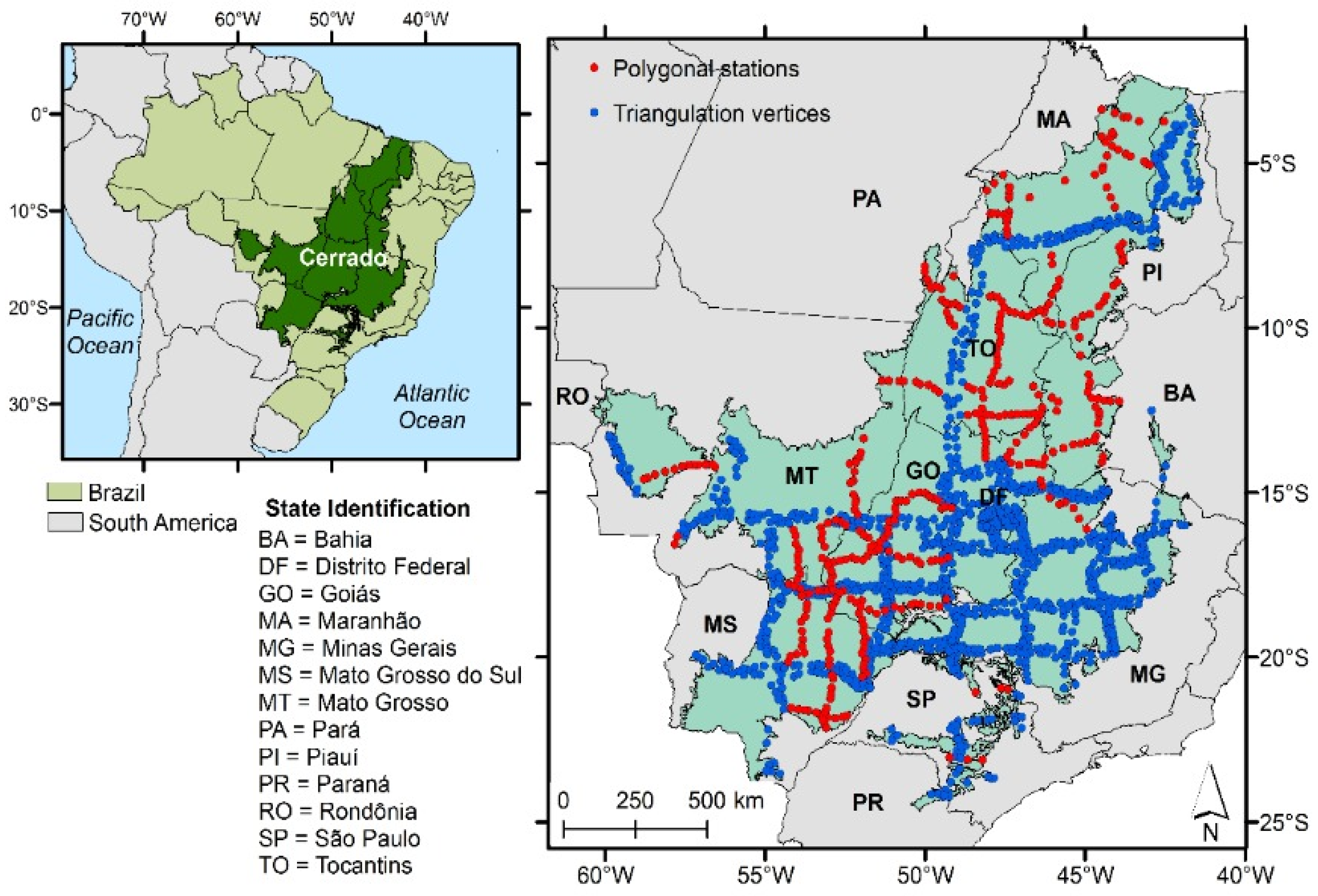
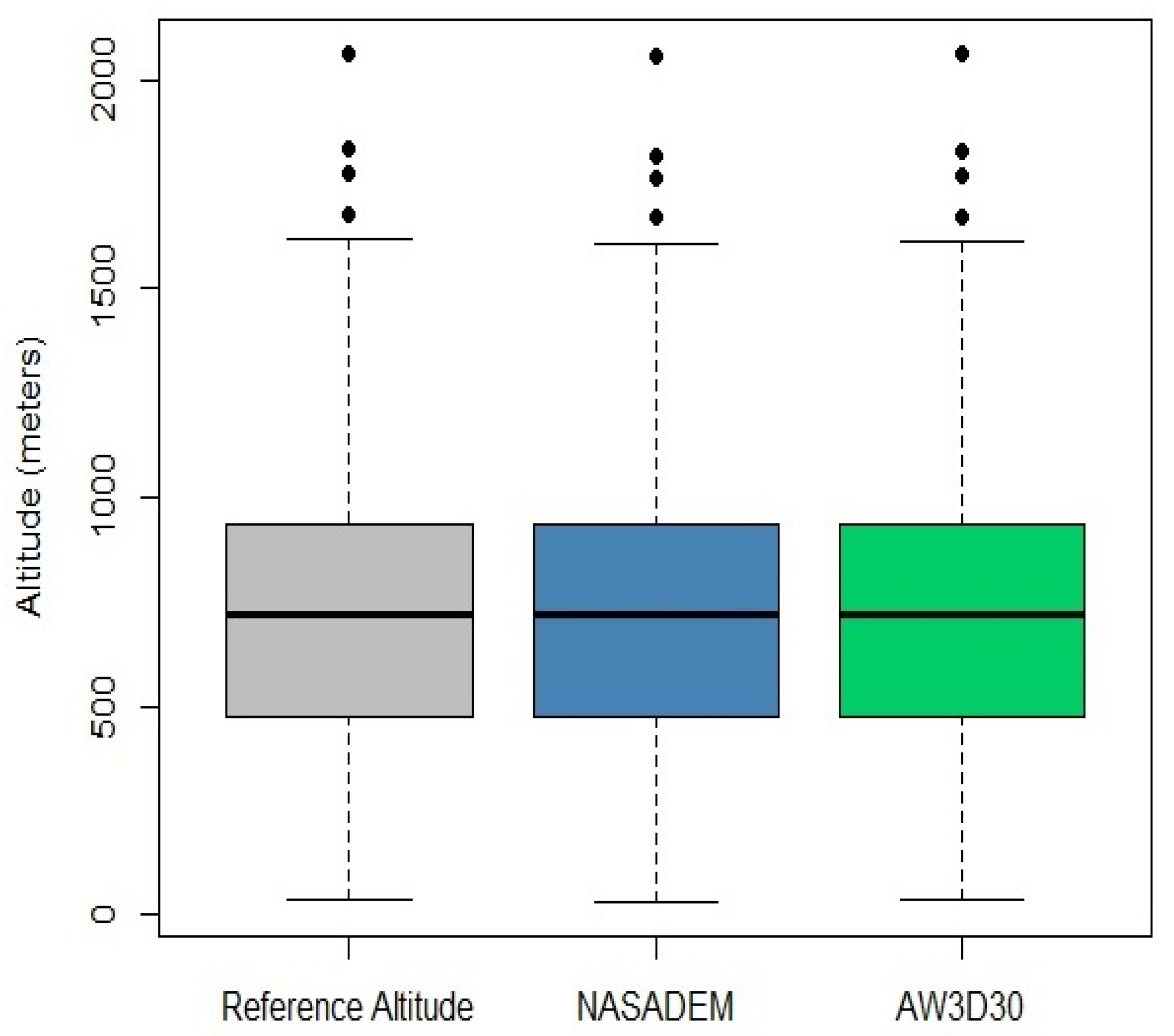


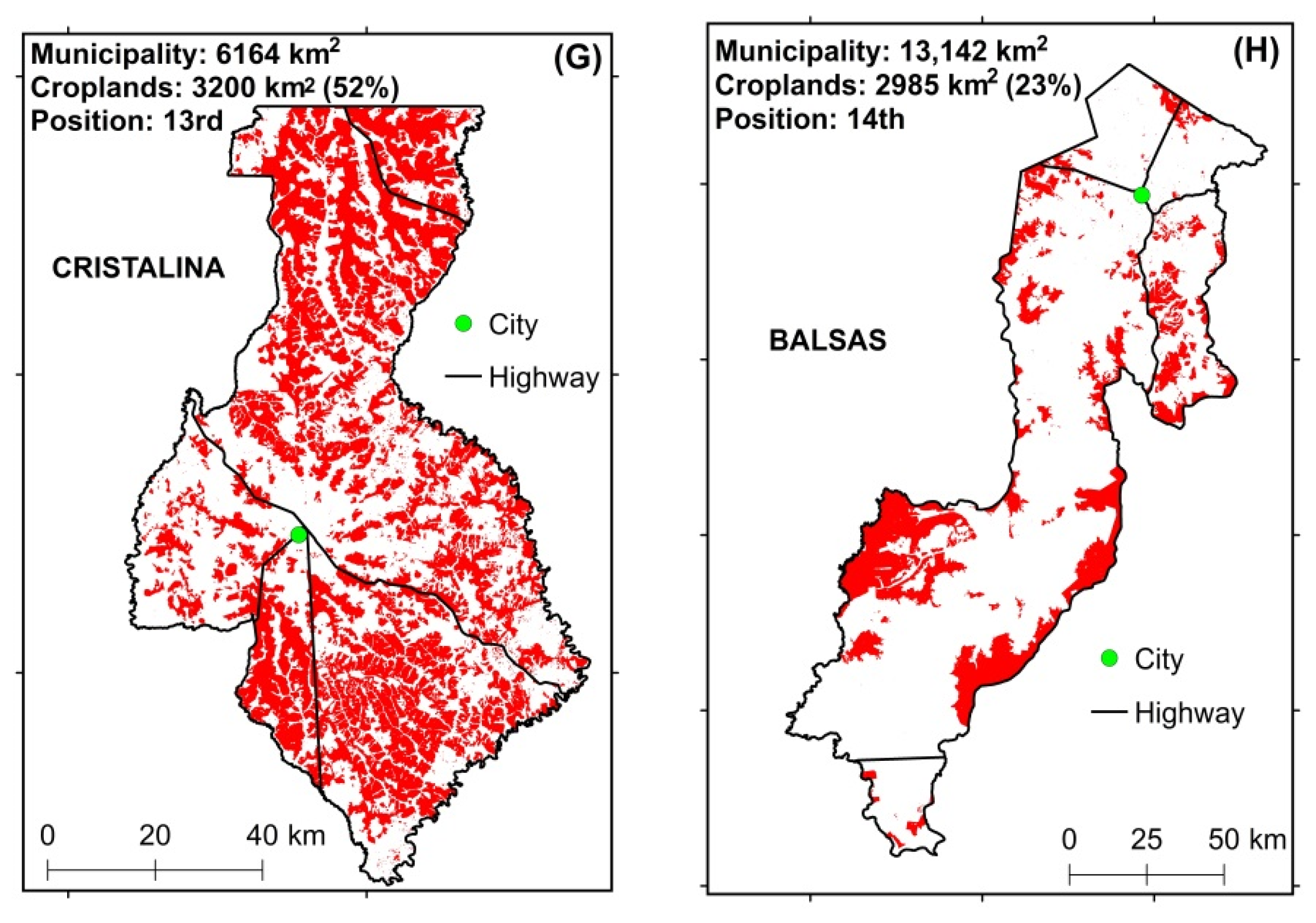

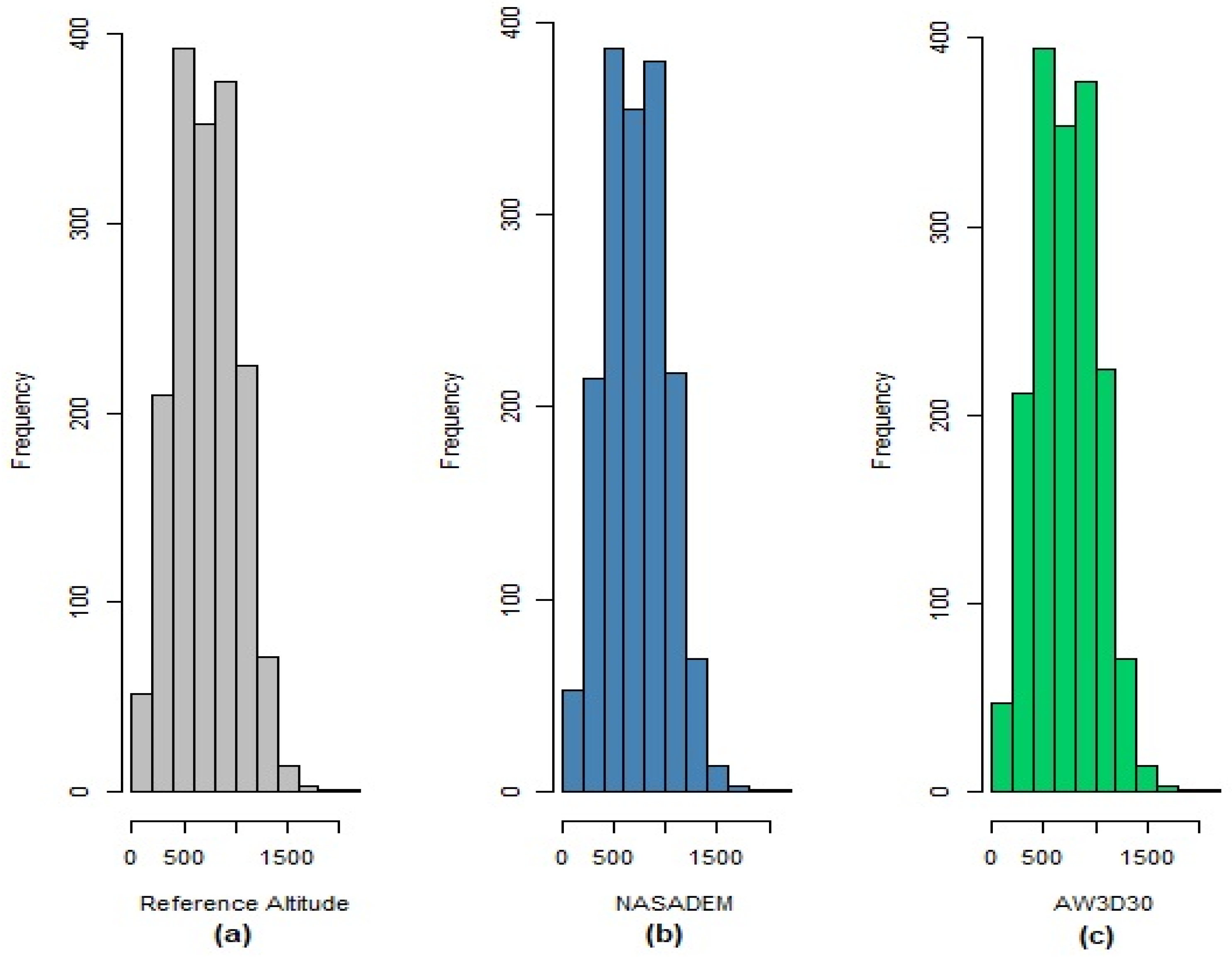
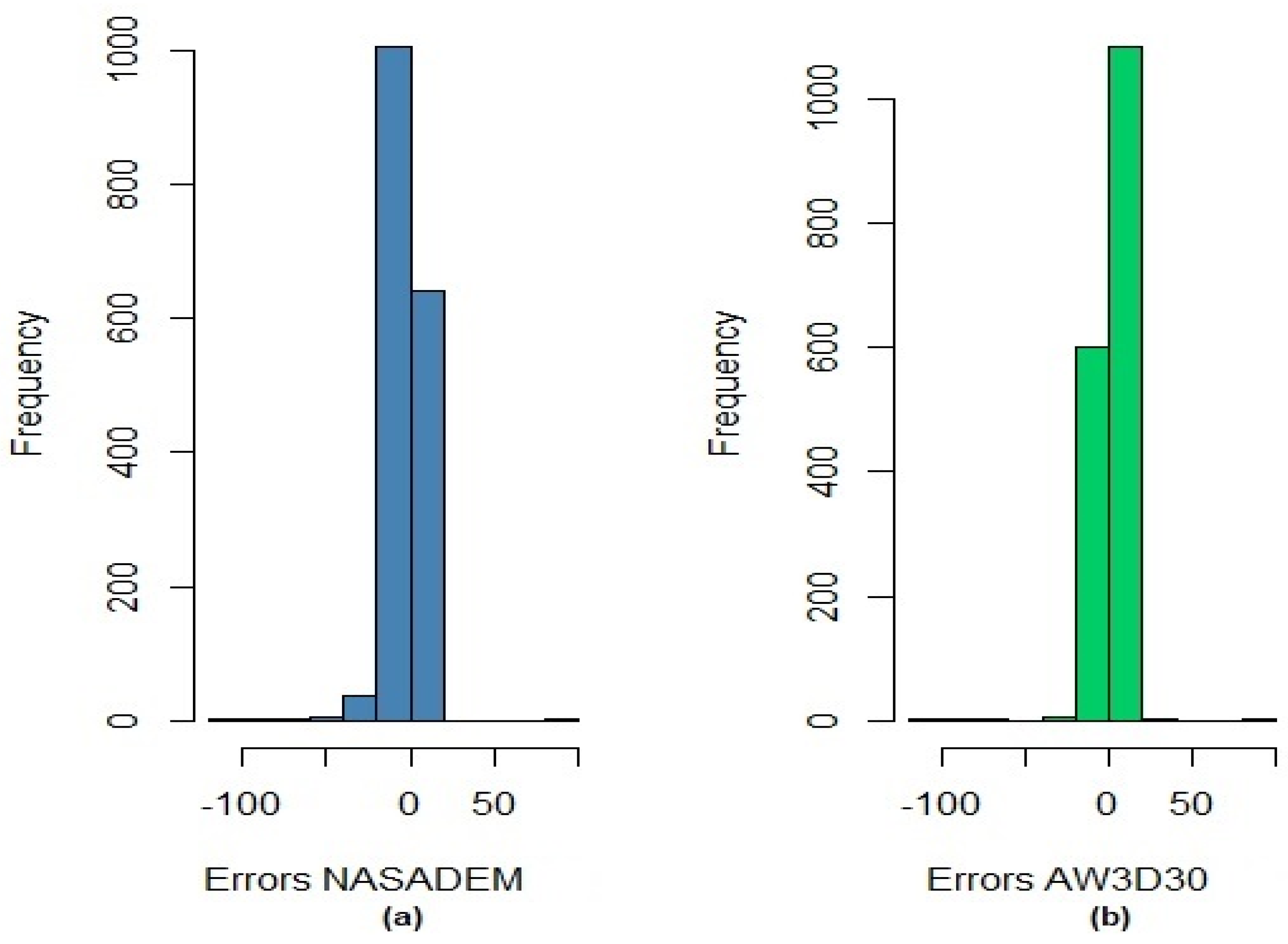
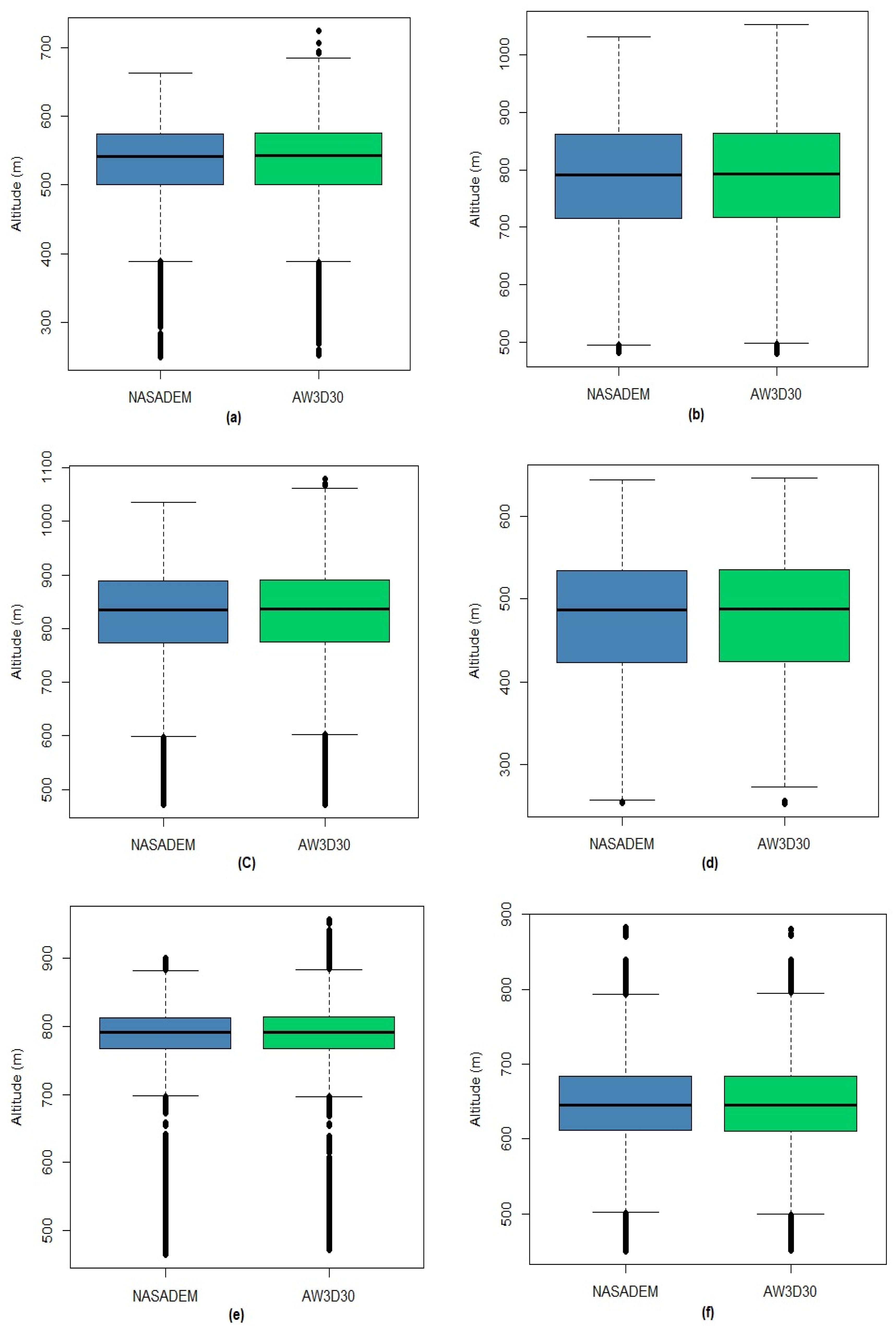
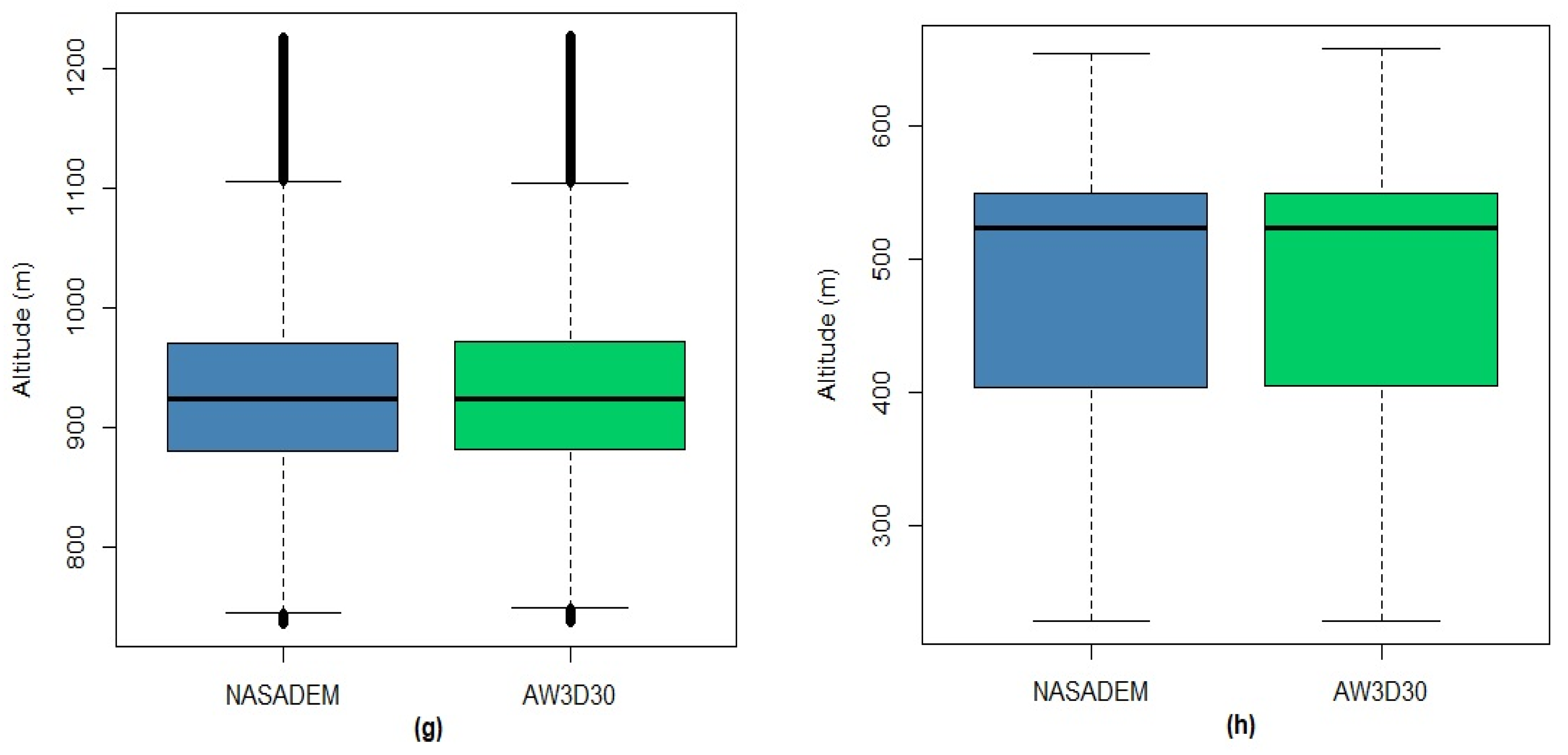

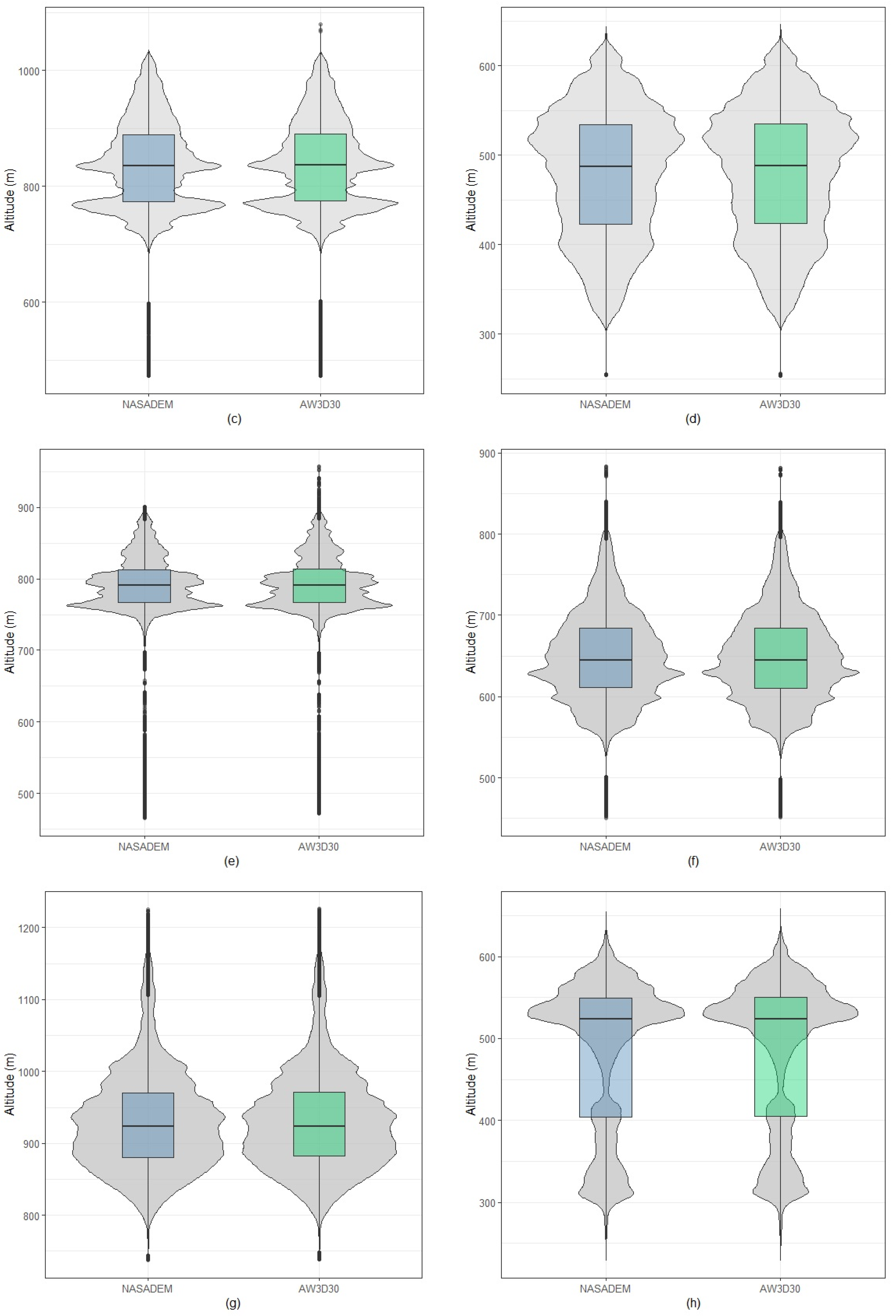
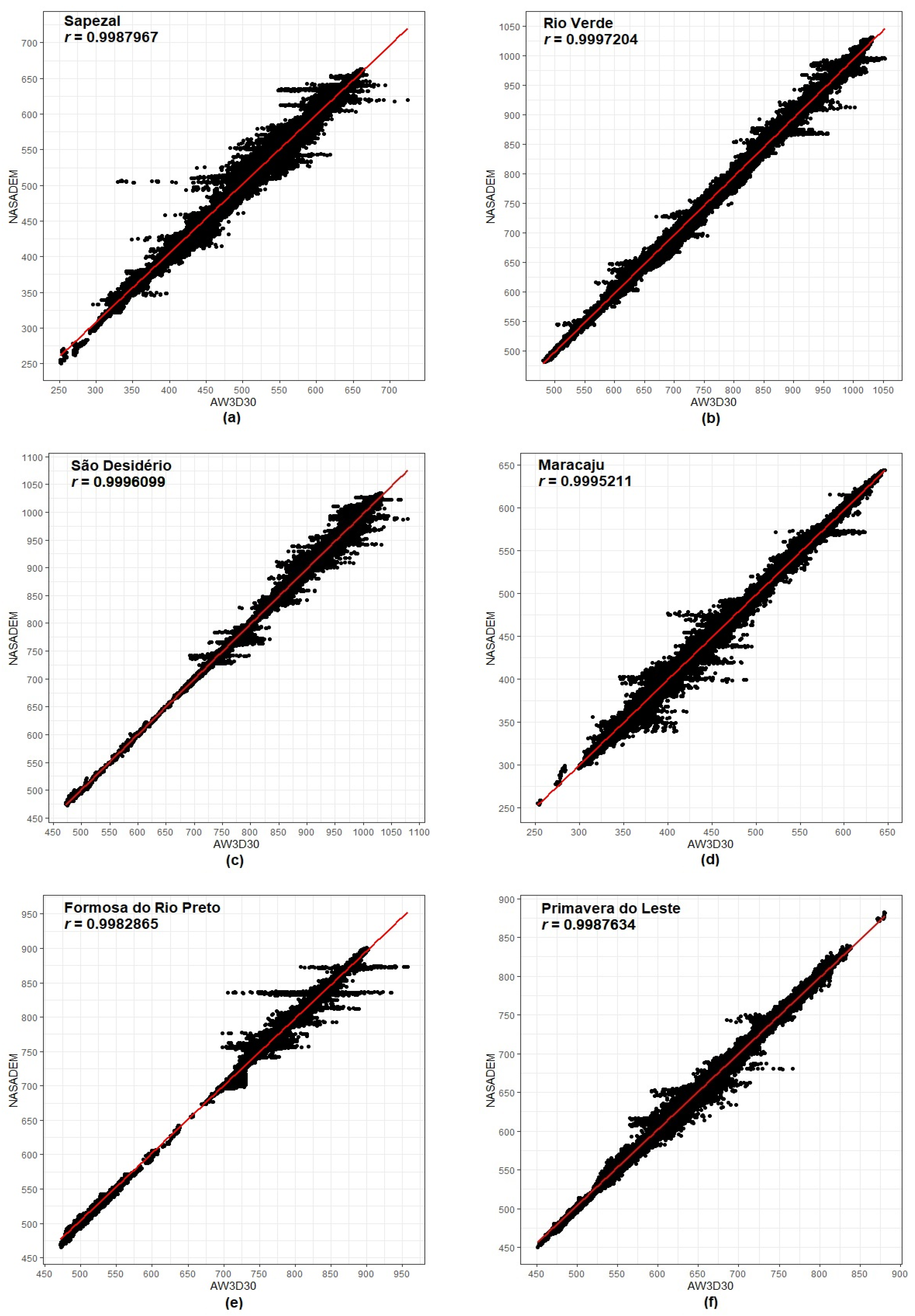

| Scale | Class | |||||||
|---|---|---|---|---|---|---|---|---|
| A | B | C | D | |||||
| PEC (m) | EP (m) | PEC (m) | EP (m) | PEC (m) | EP (m) | PEC (m) | EP (m) | |
| 1:1000 | 0.27 | 0.17 | 0.50 | 0.33 | 0.60 | 0.40 | 0.75 | 0.50 |
| 1:2000 | 0.27 | 0.17 | 0.50 | 0.33 | 0.60 | 0.40 | 0.75 | 0.50 |
| 1:5000 | 0.54 | 0.34 | 1.00 | 0.66 | 1.20 | 0.80 | 1.50 | 1.00 |
| 1:10,000 | 1.35 | 0.84 | 2.50 | 1.67 | 3.00 | 2.00 | 3.75 | 2.50 |
| 1:25,000 | 2.70 | 1.67 | 5.00 | 3.33 | 6.00 | 4.00 | 7.50 | 5.00 |
| 1:50,000 | 5.50 | 3.33 | 10.00 | 6.66 | 12.00 | 8.00 | 15.00 | 10.00 |
| 1:100,000 | 13.70 | 8.33 | 25.00 | 16.66 | 30.00 | 20.00 | 37.50 | 25.00 |
| 1:250,000 | 27.00 | 16.67 | 50.00 | 33.33 | 60.00 | 40.00 | 75.00 | 50.00 |
| Product | Description | Data Type | Units | Fill Value | No Data Value | Valid Range | Scale Factor |
|---|---|---|---|---|---|---|---|
| NASADEM_HGT: NASADEM Merged DEM Product Grouping | |||||||
| hgt | Void-filled DEM merge | 2-byte signed integer | meters (relative to the EGM96 geoid) | N/A | N/A | −32,767 to 32,767 | N/A |
| num | NUM file associated with hgt file | byte | Class: 1–255 (see “Reference Data for Number of Scenes Layer”) | N/A | N/A | 0 to 255 | N/A |
| swb | Updated SRTM water body data | byte | Class: 0 for land; 255 for water | N/A | N/A | 255 | N/A |
| NASADEM_SC: NASADEM Slope and Curvature Product Grouping | |||||||
| slope | Slope derived from hgt | 2-byte unsigned integer | hundreds of degrees (0 = water) | 0 | NaN | Non-negative | See Units |
| aspect | Slope aspect angle derived from hgt | 2-byte unsigned integer | Hundreds of degrees clockwise from North (0 = water) | 0 | NaN | Non-negative | See Units |
| plan (planc) | Plan curvature derived from hgt | 4-byte real | Inverse meters (0 = water) | 0 | NaN | - | N/A |
| profile (profc) | Profile curvature derived from hgt | 4-byte real | Inverse meters (0 = water) | 0 | NaN | - | N/A |
| swbd (swb) | Updated SRTM water body data | byte | Class: 0 for land; 255 for water | N/A | N/A | 255 | N/A |
| NASADEM_SSP: NASADEM SRTM Subswath Product Grouping | |||||||
| tot.cor | Radar total correlation | 2-byte unsigned integer | correlation value × 10,000 (0 = void) | 0 | N/A | Non-negative | See Units |
| vol.cor | Radar volumetric correlation | 2-byte unsigned integer | correlation value × 10,000 (0 = void) | 0 | N/A | Non-negative | See Units |
| img | Radar individual images | Byte | DN + 128 (0 = void) (i.e., fileValue = 10 × log10(actualValue) + 128) | 0 | N/A | - | See Units |
| Inc0 | Radar incidence angle (relative to ellipsoid) | 2-byte unsigned integer | hundreds of degrees (0 = void) | 0 | N/A | Non-negative | See Units |
| inc | Radar incidence angle (local) | 2-byte unsigned integer | hundreds of degrees (0 = void) | 0 | N/A | Non-negative | See Units |
| NASADEM_SIM: NASADEM SRTM Image Mosaic Product Grouping | |||||||
| Img_comb (img) | Radar combined images | byte | DN + 128 (0 = void) (i.e., fileValue = 10 x log10 (actualValue) + 128) | 0 | N/A | - | See Units |
| img_comb_num (img.num) | NUM file associated with combined images | byte | Number of pixels averaged for each img_comb output pixel | 0 | N/A | 0 to 10 | N/A |
| NASADEM_SHHP: NASADEM SRTM-only Height and Height Precision Product Grouping | |||||||
| Hgt_srtmOnly (hgts) | SRTM-only floating-point DEM | 4-byte real | meters (relative to the WGS84 ellipsoid) | −32,768 | N/A | - | N/A |
| err | Height error (precision) | 2-byte unsigned integer | millimeters (32,769 = void) | 32,769 | N/A | Non-negative | N/A |
| Dataset | Imaging System | Wavelength | Pixel Spacing | Horizontal Accuracy | Vertical Accuracy |
|---|---|---|---|---|---|
| NASADEM_HGT | SAR C-band | 5.66 cm | 30 m | 20 m (CE90) | 16 m (LE90) |
| ALOS AW3D | PRISM | 0.52–0.77 μm | 5 m | 5 m (RMSE) | 5 m (RMSE) |
| Parameter | Test of Normality | |
|---|---|---|
| Shapiro–Wilk | Anderson–Darling | |
| Reference altitude | 0.001 | 0.001 |
| NASADEM_HGT | 0.001 | 0.001 |
| AW3D30 | 0.001 | 0.001 |
| Municipality (State) | Position in the Cerrado in Terms of Grain Production | Harvested Area (ha) |
|---|---|---|
| Sapezal (MT) | 2nd | 663,198 |
| Rio Verde (GO) | 3rd | 601,210 |
| São Desidério (BA) | 4th | 559,763 |
| Maracaju (MS) | 5th | 545,458 |
| Formosa do Rio Preto (BA) | 7th | 489,137 |
| Primavera do Leste (MT) | 9th | 410,000 |
| Cristalina (GO) | 13th | 320,000 |
| Balsas (MA) | 14th | 298,495 |
| Variable | Min | Max | Mean | SD | Q1 | Q2 | Q3 | CV (%) |
|---|---|---|---|---|---|---|---|---|
| Reference altitude | 35.37 | 2061.76 | 716.48 | 297.78 | 476.66 | 721.81 | 936.28 | 41.56 |
| NASADEM_HGT | 31.77 | 2056.24 | 713.58 | 297.44 | 471.36 | 718.32 | 933.38 | 41.68 |
| AW3D30 | 36.77 | 2061.24 | 717.17 | 297.37 | 474.51 | 719.04 | 936.16 | 41.46 |
| Scale | Class | Standard Error EP (m) | PEC (m) | Percentage (%) | |
|---|---|---|---|---|---|
| NASADEM_HGT | AW3D30 | ||||
| 1:25,000 | A | 1.67 | 2.70 | 49 | 60 |
| 1:25,000 | B | 3.33 | 5.00 | 69 | 85 |
| 1:50,000 | A | 3.33 | 5.50 | 72 | 87 |
| 1:50,000 | B | 6.66 | 10.00 | 86 | 96 |
| 1:100,000 | A | 8.33 | 13.70 | 92 | 99 |
| 1:100,000 | B | 16.66 | 25.00 | 98 | 100 |
| 1:250,000 | A | 16.67 | 27.00 | 99 | 100 |
| 1:250,000 | B | 33.33 | 50.00 | 100 | 100 |
| Variable | Test of Normality | |
|---|---|---|
| Shapiro–Wilk | Anderson–Darling | |
| NASADEM_HGT errors | 0.001 | 0.001 |
| AW3D30 errors | 0.001 | 0.001 |
| Parameters | NASADEM_HGT | AW3D30 |
|---|---|---|
| Minimum error | −109.72 | −108.72 |
| Maximum error | 96.80 | 97.80 |
| Mean error or bias (tendency) | −2.90 | 0.69 |
| Standard deviation (precision) | 8.39 | 6.11 |
| Root mean square error (RMSE) (accuracy) | 8.88 | 6.15 |
| Municipality | DEM | Number of Pixels | Min. (m) | Max. (m) | Mean (m) | SD (m) | Q1 (m) | Q2 (m) | Q3 (m) | CV (%) |
|---|---|---|---|---|---|---|---|---|---|---|
| Sapezal | NASADEM | 4,691,742 | 250 | 663 | 533.19 | 59.40 | 500 | 542 | 574 | 11.14 |
| AW3D30 | 4,691,742 | 252 | 724 | 533.60 | 59.86 | 500 | 543 | 575 | 11.22 | |
| Rio Verde | NASADEM | 5,341,106 | 481 | 1031 | 786.07 | 103.38 | 715 | 791 | 862 | 13.15 |
| AW3D30 | 5,341,106 | 480 | 1053 | 788.03 | 103.56 | 717 | 792 | 864 | 13.14 | |
| São Desidério | NASADEM | 6,222,247 | 472 | 1035 | 838.44 | 72.49 | 773 | 835 | 889 | 8.65 |
| AW3D30 | 6,222,247 | 472 | 1079 | 839.45 | 72.11 | 775 | 836 | 890 | 8.59 | |
| Maracaju | NASADEM | 3,603,927 | 254 | 644 | 478.66 | 70.95 | 423 | 487 | 534 | 14.82 |
| AW3D30 | 3,603,927 | 253 | 646 | 479.71 | 71.14 | 424 | 488 | 535 | 14.83 | |
| Formosa do Rio Preto | NASADEM | 5,696,443 | 465 | 901 | 794.13 | 35.74 | 767 | 791 | 813 | 4.50 |
| AW3D30 | 5,696,443 | 472 | 957 | 794.43 | 36.09 | 767 | 791 | 814 | 4.54 | |
| Primavera do Leste | NASADEM | 3,511,471 | 450 | 883 | 649.37 | 53.43 | 611 | 645 | 684 | 8.23 |
| AW3D30 | 3,511,471 | 451 | 881 | 649.06 | 53.35 | 610 | 645 | 684 | 8.22 | |
| Cristalina | NASADEM | 3,039,881 | 737 | 1225 | 930.38 | 69.26 | 880 | 923 | 970 | 7.44 |
| AW3D30 | 3,039,881 | 738 | 1226 | 931.26 | 68.99 | 882 | 924 | 971 | 7.41 | |
| Balsas | NASADEM | 2,774,848 | 229 | 655 | 483.22 | 91.99 | 404 | 524 | 549 | 19.04 |
| AW3D30 | 2,774,848 | 229 | 658 | 484.29 | 91.71 | 405 | 524 | 550 | 18.94 |
| Cohen Effect | Interpretation |
|---|---|
| 1.30 | Very high |
| 0.80–1.29 | High |
| 0.50–0.79 | Medium |
| 0.20–0.49 | Low |
| 0.19 | Not significant |
| Municipality | Mean Altitude | Mean Difference | Cohen Effect | Interpretation | |
|---|---|---|---|---|---|
| NASADEM_HGT | AW3D30 | ||||
| Sapezal | 533.19 | 533.60 | 0.40 | 0.00678507 | Not significant |
| Rio Verde | 786.07 | 788.03 | 1.95 | 0.01889108 | Not significant |
| São Desidério | 838.44 | 839.45 | 1.00 | 0.01388478 | Not significant |
| Maracaju | 478.66 | 479.71 | 1.05 | 0.01472942 | Not significant |
| Formosa do Rio Preto | 794.13 | 794.43 | 0.29 | 0.008158326 | Not significant |
| Primavera do Leste | 649.37 | 649.06 | 0.31 | 0.005793891 | Not significant |
| Cristalina | 930.38 | 931.26 | 0.89 | 0.01281434 | Not significant |
| Balsas | 483.22 | 484.29 | 1.07 | 0.01164616 | Not significant |
Publisher’s Note: MDPI stays neutral with regard to jurisdictional claims in published maps and institutional affiliations. |
© 2021 by the authors. Licensee MDPI, Basel, Switzerland. This article is an open access article distributed under the terms and conditions of the Creative Commons Attribution (CC BY) license (https://creativecommons.org/licenses/by/4.0/).
Share and Cite
Bettiol, G.M.; Ferreira, M.E.; Motta, L.P.; Cremon, É.H.; Sano, E.E. Conformity of the NASADEM_HGT and ALOS AW3D30 DEM with the Altitude from the Brazilian Geodetic Reference Stations: A Case Study from Brazilian Cerrado. Sensors 2021, 21, 2935. https://doi.org/10.3390/s21092935
Bettiol GM, Ferreira ME, Motta LP, Cremon ÉH, Sano EE. Conformity of the NASADEM_HGT and ALOS AW3D30 DEM with the Altitude from the Brazilian Geodetic Reference Stations: A Case Study from Brazilian Cerrado. Sensors. 2021; 21(9):2935. https://doi.org/10.3390/s21092935
Chicago/Turabian StyleBettiol, Giovana Maranhão, Manuel Eduardo Ferreira, Luiz Pacheco Motta, Édipo Henrique Cremon, and Edson Eyji Sano. 2021. "Conformity of the NASADEM_HGT and ALOS AW3D30 DEM with the Altitude from the Brazilian Geodetic Reference Stations: A Case Study from Brazilian Cerrado" Sensors 21, no. 9: 2935. https://doi.org/10.3390/s21092935







